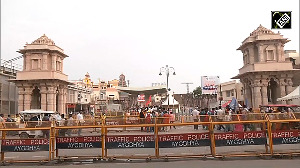'If the government spends Rs 10 lakh crore this year, then you would be looking at a GDP growth of minus 5 per cent.'
'If you do not do this, you will be looking at GDP growth between minus nine and minus 10 per cent.'

At his third press briefing since the COVID-19 pandemic began gnawing at the Indian economy on May 22, Reserve Bank of India Governor Shaktikanta Das announced that the RBI would lend money to banks (repo rate) at 4 per cent, which stood at 4.4 per cent just a month ago.
The rate at which banks keep their excess liquidity with the RBI (reverse repo rate) too was brought down 3.35 per cent from 3.75 per cent.
Interestingly, while the RBI acknowledged for the first time how badly the Indian economy was reeling under COVID-19, Governor Das made his aggression clear when he announced that 'The monetary policy committee (which decides these rates; this time the MPC voted 5:1 in favour of a repo rate cut) will continue with its accommodative stance as long as it is necessary to revive growth and mitigate the impact of COVID-19 on the Indian economy.'
But is this enough to spur demand and revive the Indian economy?
"The situation is very grim. I don't think there is enough appreciation (among the decision makers in the central government) of the kind of income losses that have taken place," Dr Pronab Sen, former chairman, Indian Statistical Commission, tells Prasanna D Zore/Rediff.com.
How do you look at the RBI's measure to cut the repo rate by 4 per cent and extension of the loan moratorium?
Basically, this repo rate cut is designed to get the lending rates down and that is what will happen going ahead.
What is going to happen is that all these loans that were taken earlier will become cheaper.
But I must say that the original (loan) moratorium was badly designed.
Because what it involved was accumulation of interest for three months and then payment of the whole amount at one shot.
Basically, the borrowers were facing a situation where without earnings, they would have had a large accumulated interest payment to make.
So they (mostly the industries/companies that availed the moratorium facility) said that you first extend the moratorium by another three months and then convert that accumulated interest into a term loan, which will be payable over the next six months or so.
So, they (the RBI) have taken care of that problem (by making an announcement to that effect) and that is a good thing.
Could these extensions of moratorium lead to an increase in NPAs in the books of lenders assuming that individuals, companies in the MSME sector could default on their payments when the moratorium gets over?
You see, loan defaults are going to happen anyway because already a lot of damage has happened and a lot of these MSMEs (micro, small and medium enterprises) will not be able to pay back their loans.
Remember, the MSMEs, post demonetisation and GST, were having trouble paying back their loan. (In such circumstances), over and above their loans, they took Mudra loans.
As a result, they already have very high debt liabilities. That's like revolving their credit.
While they may be able to revolve it a little bit more but somewhere down the line the buck will stop.
Where does that leave the financial system? Will this lead to a financial crisis going ahead?
There is going to be financial damage one way or the other. This is why guarantees and recapitalisation (of banks) are essential.
The government has given some guarantees (in the financial package announced by Finance Minister Nirmala Sitharaman and subsequent announcements made by RBI Governor Shaktikanta Das) recently).
On the past loans, though, there are no guarantees.
The Rs 3 lakh crore loans that banks are supposed to make are the ones that will be guaranteed, but remember there is a fair amount of NPAs in the banks'; balancesheets (because of the loans advanced prior to that).
To take care of these NPAs, you will have to come up with (another) recapitalisation package for banks.
But does the government have enough fiscal room to do go for another recapitalisation package?
I don't even understand the term fiscal room. What is the fiscal room for the central government?
(Is) there fiscal room for state governments? Yes, I understand (that there isn't much). But fiscal room for central government, I don't even understand the concept.
There is always criticism of this government that it first looks at what the global credit ratings agencies will say about India's sovereign ratings and then decides what and how much to fiscal package to give?
That is kind of stupid (of the government).
If that's what they are doing then they are being extremely silly.
What role do credit rating agencies play except its indicated use by the foreign portfolio investors?
Since we don't borrow globally and we have not much international borrowings, the ratings don't really matter.
What could the government do to help the revival of the Indian economy?
The only and only one bullet point is that the central government must come up with a substantial fiscal stimulus.
At the moment, the fiscal stimulus is zero.
Could you outline what this 'substantial' fiscal stimulus should look like? What would you expect the government to do?
My estimate of the minimum fiscal stimulus this year should be in the range of Rs 10 lakh crore.
The financial package that has been announced (by the finance minister) is not fiscal stimulus.
In that the actual budgetary contribution is only Rs 2.5 lakh crore.
If you deduct from the cuts that the government has already made -- and they made a lot of cuts -- to the budgetary expenditure, then that two-and-a-half lakh crore comes down to one- and-a-half lakh crore.
So, the net additional government expenditure is actually very low. It's probably less than one-and-a-half lakh crore.
As a result, the government will have to make provisions for eight-and-a-half lakh crore of additional resources to step up demand this year.
If the government spends Rs 10 lakh crore this year, then you would be looking at a GDP growth of minus 5 per cent.
If you (the central government) do not do this, you will be looking at GDP growth between minus nine and minus 10 per cent.
The situation is very grim.
I don't think there is enough appreciation (among the decision makers in the central government) of the kind of income losses that have taken place (since the nationwide lockdown was announced).











 © 2025
© 2025